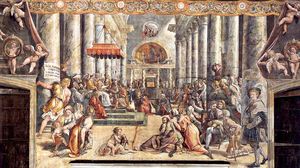Tradition relates that Constantine the Great was converted to Christianity by a miracle. One evening, in 312 A.D., near Rome, while he was in the midst of a bloody battle with Maxentius for control of the western portion of the Roman Empire, Constantine saw a radiant cross appear in the heavens. Around it was the inscription: “By this sign thou shalt conquer”. He took this as a sign that the God of the Christians was the true Deity, not the numerous Roman gods with which he was familiar.
Because of this religious experience, the years of bitter persecution which had plagued the early Christians under Roman rule were ended, and Christianity eventually became the official religion of the Roman Empire.
Gaius Flavius Valerius Aurelius Constantinus was born in 274 at Naissus (in present-day Serbia). He was the son of Constantius Chlorus, a Roman army officer, and Helena, a Christian, of a lower class.
In 306, upon the death of his father, Constantine became emperor of Britain, Gaul, Spain and the Germanic provinces. He defeated his brother-in-law and rival, Maxentius, at the Battle at the Milvian Bridge, and gained control of Italy. It was during this battle that he was reported to have received the sign. After he ordered his troops to adorn their shields with a cross, they were victorious.
Constantine came to power in a period of confusing politics. In the Roman Empire of the early 300s, emperors changed quickly. At one point, the empire had four contesting emperors.
Constantine became Emperor of the Western Empire, having formed an alliance with Licinius, who was Emperor of the East.
The two emperors met at Milan in 313 and issued the “Edict of Milan”. This edict mandated official tolerance of Christianity and all other religions. Sundays and feasts of Christian martyrs were granted the same recognition as pagan feasts. The penalty of crucifixion and the barbaric gladiatorial shows were abolished. Christian clergy were exempt from all taxes, and from military service, as were the pagan priests.
Co-operation between the two emperors didn’t last long. When Licinius began persecuting the Christians again, Constantine attacked and defeated him. In 324, Constantine became the sole ruler of the Roman Empire.
It has been suggested that Constantine’s support of Christianity was driven more by political motives rather than by personal faith. This view was strengthened by the fact that, in 326, he had his wife, Fausta and his eldest son, deputy emperor Crispus, killed..
It was later rumoured that Fausta had accused Crispus, her stepson, of rape in order to ensure the line of succession for her own sons. After Crispus was executed, it was discovered that she had lied, and this resulted in her own death.
In 324, Constantine began rebuilding Byzantium, renaming it Nova Roma. (New Rome). As the structures of the new city are completed, it was again renamed: Constantinople. The capital of the empire was thus relocated from Rome to Constantinople.
Constantine had hoped that Christianity would be a unifying force within the empire. However, the heresy of Arianism arose, which proposed that Christ was greater than man, but inferior to God.
In 325, Constantine convened the Council of Nicea with full confidence that the bishops would work out their differences. This was the first “Ecumenical Council” because it included bishops from different regions. It condemned the teachings of Arius and adopted a Creed giving the correct information about the Son’s relationship to the Father.
The Nicene Creed is still extant in major Christian churches today.
Constantine had many churches built, including the Church of the Nativity in Bethlehem and the Church of the Holy Sepulchre in Jerusalem.
He promoted the copying and distribution of the Scriptures.
Constantine died in 337, at Nicomedia. He was baptized shortly before his death, as was the custom at that time. He was succeeded by his three sons, Constantius II, Constantine II, and Constans.
At the beginning of the fourth century, only 10% of the Roman Empire’s people were Christian. At the end of the century, Christians made up 90% of the population. The Church enjoyed unparalleled growth during the age of Constantine. He contributed significantly to the growth of the early Christian Church.
He is regarded as a saint, especially by Eastern Orthodox Christians. His feast day is celebrated on May 21.




